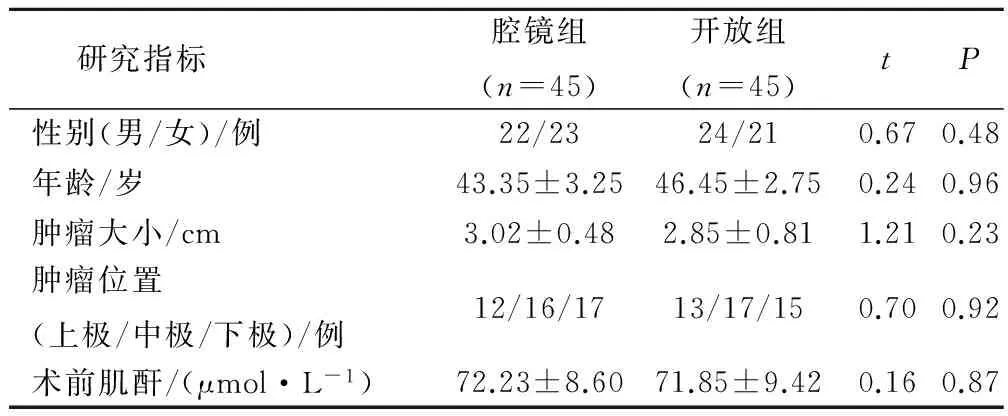腹腔镜下保留肾单位手术与开放手术治疗肾肿瘤的疗效比较
石奇刚 孙永恒 任艳胜
腹腔镜下保留肾单位手术与开放手术治疗肾肿瘤的疗效比较
石奇刚 孙永恒 任艳胜
目的 比较腹腔镜下保留肾单位手术(RLNSS)与开放手术(ONSS)治疗肾肿瘤(RT)的疗效。方法 选取肾肿瘤患者90例,其中采用RLNSS治疗的45例患者为腔镜组,采用ONSS进行治疗的45例为开放组,记录并比较两组患者的手术时间、术中出血量、术中肾脏缺血阻断时间、住院天数、术后肠道功能恢复时间、术前及术后复查的肌酐水平、术后并发症发生情况。结果 腔镜组和开放组患者在年龄、性别、肿瘤大小、肿瘤位置、TNM分期、术前肌酐等方面差异无统计学意义(P>0.05)。腔镜组良性肿瘤5例,恶性肿瘤40例;开放组良性肿瘤6例,恶性肿瘤39例,两组对比差异无统计学意义(P>0.05)。腔镜组平均手术时间(128.55±13.56)min,开放组为(127.86±10.41)min,两组对比差异无统计学意义(P>0.05)。腔镜组术中平均出血量为(200.86±20.45)ml,开放组为(362.20±29.42)ml,差异具有统计学意义(P<0.05)。腔镜组患者平均肾脏缺血阻断时间为(29.45±2.50)min,明显高于开放组的(19.95±2.64)min,差异具有统计学意义(P<0.05)。术后复查肌酐水平,两组比较差异无统计学意义(P>0.05)。腔镜组患者平均住院天数为(7.56±1.25)d,明显短于开放组的(10.50±1.56)d,差异具有统计学意义(P<0.05)。腔镜组术后肠道功能恢复时间为(1.10±0.80)d,明显短于开放组的(2.20±1.32)d。腔镜组患者胸膜损伤2例,开放组胸膜损伤5例,术中大出血8例,并发症发生率为28.89%,明显高于腔镜组的4.44%,差异具有统计学意义(P<0.05)。术后随访过程中,两组患者均未发现RT复发和转移。结论 RLNSS在肾肿瘤的治疗中有安全性高、术中出血量少、并发症发生率低等优点,术后无RT复发和转移,是一种比ONSS更加有效的治疗方法。
腹腔镜;保留肾单位;肾肿瘤;开放手术
(ThePracticalJournalofCancer,2017,32:451~454)
肾肿瘤是泌尿系统常见的肿瘤之一,多为恶性肿瘤,主要包括源自肾实质的肾母细胞瘤、肾细胞癌和移行细胞乳头状肿瘤,其中肾母细胞瘤在婴幼儿中发病率较高,约占婴幼儿恶性肿瘤的五分之一[1-2]。根治性肾切除(radical nephrectomy,RN)最早应用于对RT患者的治疗,由于其疗效显著很快得到了患者的广泛认可。随着诊断技术的不断进步,RT患者早期就能够被诊断出来,在这种情况下,ONSS出现并得到了快速发展[3-4]。RN与ONSS的结合可以对RT患者进行有效的治疗,极大地提高了肾肿瘤的治愈率并降低了并发症的发生率。本次研究通过采用ONSS和RLNSS分别对肾肿瘤患者进行治疗,将术后患者病理情况比较,评估RLNSS在治疗肾肿瘤方面的功效,为肾肿瘤治疗提出更加有效的治疗方案。
1 资料与方法
1.1 一般资料
选取2013年1月至2015年12月间在我医院住院治疗的肾肿瘤患者90例,其中采用RLNSS治疗的45例患者为腔镜组,男性22例,女性23例,平均年龄(43.35±3.25)岁,年龄17~58岁,采用ONSS进行治疗的45例为开放组,男性24例,女性21例,平均年龄(46.45±2.75)岁,年龄18~63岁。两组患者年龄、性别间差异无统计学意义(P>0.05)。本研究获我院伦理委员会批准,患者或近亲属对研究方案签署知情同意书。
1.2 患者入选标准
患者经检查诊断为单发局限性肾肿瘤,肿瘤直径≤4 cm;肿瘤未发生局部转移;无其他肾病。
1.3 排除标准
患有其他肿瘤如:肾转移癌、尿路上皮癌等; RT已经局部或远处转移;肿瘤直径>4 cm;患者不同意参与此次研究。
1.4 手术方法
腔镜组采用后腹腔镜下肾肿瘤保留肾单位手术,开放组采用开放保留肾单位手术,记录并比较两组患者的手术时间、术中出血量、术中肾脏缺血阻断时间、住院天数、术后肠道功能恢复时间、术前及术后复查的肌酐水平、术后并发症发生情况。术后对患者进行回访,观察RT的复发情况。
1.5 随访方法
患者术后1年内每3个月进行一次随访,术后第2、3年每6个月随访一次,记录患者的肌酐水平、肾功能及RT转移复发情况,并统计患者的3~36个月的术后生存率。
1.6 统计学方法
应用SPSS 20.0统计学软件对实验所得所有数据进行处理和分析,组内和组间数据比较采用t检验,P<0.05视为差异具有统计学意义。
2 结果
2.1 两组患者一般资料比较
腔镜组和开放组患者在年龄、性别、肿瘤大小、肿瘤位置、术前肌酐等方面差异无统计学意义(P>0.05)(表1)。

表1 两组患者一般资料比较
2.2 两组患者术中指标比较
腔镜组平均手术时间为(128.55±13.56)min,开放组为(127.86±10.41)min,两组对比差异无统计学意义(P>0.05)。腔镜组术中平均出血量(200.86±20.45)ml,开放组为(362.20±29.42)ml,差异具有统计学意义(P<0.05)。腔镜组患者平均肾脏缺血阻断时间为(29.45±2.50)min,明显高于开放组的(19.95±2.64)min,差异具有统计学意义(P<0.05)。
2.3 两组患者术后指标比较
术后肌酐水平比较,两组差异无统计学意义(P>0.05)。腔镜组患者平均住院天数为(7.56±1.25)d,明显短于开放组的(10.50±1.56)d,差异具有统计学意义(P<0.05)。腔镜组术后肠道功能恢复时间为(1.10±0.80)d,明显短于开放组的(2.20±1.32)d,差异具有统计学意义(P<0.05)(表2)。

表2 两组术后指标比较
2.4 两组患者术后并发症发生情况比较
腔镜组患者胸膜损伤2例,术中无大出血;开放组胸膜损伤5例,术中大出血8例,并发症发生率为28.89%,明显高于腔镜组的4.44%,差异具有统计学意义(P<0.05)。
2.5术后随访
随访36个月,无死亡患者,腔镜组和开放组均未出现肿瘤复发及转移现象。
3 讨论
早些年间由于医疗技术落后,手术条件差,导致肾肿瘤患者的死亡率保持在较高水平,这对人们的身体健康和生活质量都会造成严重的不良影响[5-7]。保留肾单位手术在这种情况下不能得到快速的发展,直到上个世纪五十年代,保留肾单位手术才开始应用于对肾肿瘤直径较小患者的治疗[8-10]。肾脏小肿瘤的诊断困难,不能及时的发现治疗,RN的出现为肾肿瘤的治疗提供了1种更加有效的方法,得到了迅速发展[11-12]。但并不是所有肾肿瘤患者都能够采用此种方法治疗,RN的实施会极大提高患者术后肾功能衰竭的概率,因此术前应该对患者的病情进行全面的评估[13-14]。1992年腹腔镜手术出现,大量研究表明RLNSS不仅能够使患者的肾组织保留,还可以减少手术对患者的创伤,这一手术方式也得到了医生和患者的认可,目前RLNSS已经广泛应用于国内外对肾肿瘤的治疗[15-16]。
本次研究通过采用ONSS和RLNSS分别对肾肿瘤患者进行治疗,将术后患者病理情况比较,结果发现:腔镜组和开放组患者在年龄、性别、肿瘤大小、肿瘤位置、TNM分期、术前肌酐等方面差异无统计学意义(P>0.05)。术后两组患者病理比较:腔镜组良性肿瘤5例,恶性肿瘤40例;开放组良性肿瘤6例,恶性肿瘤39例,两组对比差异无统计学意义(P>0.05)。腔镜组平均手术时间(128.55±13.56)min,开放组为(127.86±10.41)min,两组对比差异无统计学意义(P>0.05)。腔镜组术中平均出血量(200.86±20.45)ml,开放组为(362.20±29.42)ml,差异具有统计学意义(P<0.05)。腔镜组患者平均肾脏缺血阻断时间(29.45±2.50)min,明显高于开放组的(19.95±2.64)分钟,差异具有统计学意义(P<0.05)。术后复查的肌酐水平比较,两组对比差异无统计学意义(P>0.05)。腔镜组患者平均住院天数为(7.56±1.25)d明显短于开放组的(10.50±1.56)d,差异具有统计学意义(P<0.05)。腔镜组术后肠道功能恢复时间为(1.10±0.80)d,明显短于开放组的(2.20±1.32)d。腔镜组患者胸膜损伤2例,开放组胸膜损伤5例,术中大出血8例,并发症发生率为28.89%,明显高于腔镜组的4.44%,差异具有统计学意义(P<0.05)。术后随访过程中,两组患者均未发现RT复发和转移。RLNSS这一手术方式保存患者的肾组织,患者的肾功能无太大损伤,因此患者的各方面病理情况都好于ONSS。ONSS和RLNSS都是有效治疗肾肿瘤的手术方式,但是与ONSS相比,RLNSS在肾肿瘤的治疗中有安全性高、术中出血量少、并发症发生率低等优点,降低了患者肾功能衰竭的概率,因此RLNSS在肾肿瘤的治疗中疗效更加显著,患者的治愈率更高。
综上所述,RLNSS是1种比ONSS更加有效的治疗肾肿瘤的手术方式,具有安全性高、术中出血量少、并发症发生率低等优点,有望被广泛应用于对肾肿瘤的临床治疗。
[1] 屈卫星,李 晶,程永毅,等.后腹腔镜下保留肾单位手术治疗T1期肾癌的临床体会(附37例报告)〔J〕.现代肿瘤医学,2014,5(10):2405-2407.
[2] Berookhim BM,Nelson CJ,Kunzel B,et al.Prospective analysis of penile length changes after radical prostatectomy〔J〕.Bju International,2014,113(5):131-136.
[3] Chu DI,Lloyd JC,Balsara ZR,et al.Variation in use of ne- phron-sparing surgery among children with renal tumors〔J〕.J Pediatr Urol,2014,10(4):724-729.
[4] Greco F,Cadeddu JA,Gill IS,et al.Current Perspectives in the Use of Molecular Imaging To Target Surgical Treatments for Genitourinary Cancers〔J〕.Eur Urol,2014,65(5):947-964.
[5] de Almeida BM,do Nascimento MF,Pereirafilho RN,et al.Immunohistochemical profile of stromal constituents and lymphoid cells over the course of wound healing in murine model〔J〕.Acta Cir Bras,2014,29(9):596-602.
[6] Mao X,Miao G,Tao X,et al.Saikosaponin a protects TBI rats after controlled cortical impact and the underlying mechanism.〔J〕.Am J Transl Res,2015,8(1):133-141.
[7] Frizelle FA,Mccormick JJ.Such a good operation.Pity we don't need it.〔J〕.Med J Aust,2014,201(1):11-12.
[8] Ghany MG,Alter H,Boone MH,et al.False pasitive results using commercial RT-PCR for hepatitis C virus (HCV) RNA: frequency and impact on clinical management〔J〕.Gastroenterology,2014,120(120):368-371.
[9] Baldomero G,Guadalupe V,Claudia R,et al.Cytoplasmic expression of SSTR2 and 5 by immunohistochemistry and by RT/PCR is not associated with the pharmacological response to octreotide〔J〕.Endocrinol Nutr,2014,61(10):523-530.
[10] Chen ZF,Schottler F,Bertram E,et al.Development and - Validation of a 3-Plex RT-qPCR Assay for the Simultaneous Detection and Quantitation of the Three PML-RARa Fusion Transcripts in Acute Promyelocytic Leukemia〔J〕.Plos One,2015,10(3):493-501.
[11] Blumenthal DT,Rankin C,Stelzer KJ,et al.A Phase Ⅲ st- udy of radiation therapy (RT) and O(6)-benzylguanine+BCNU versus RT and BCNU alone and methylation status in newly diagnosed glioblastoma and gliosarcoma:Southwest Oncology Group (SWOG) study S0001〔J〕.Int J Clin Oncol,2014,20(4):650-658.
[12] Buckner JC,Pugh SL,Shaw EG,et al.Phase Ⅲ study of radiation therapy (RT) with or without procarbazine,CCNU,and vincristine (PCV) in low-grade glioma: RTOG 9802 with Alliance,ECOG,and SWOG〔J〕.Int J Clin Oncol,2014,5(13):156-166.
[13] 张 仰.腹腔镜手术和开放手术治疗泌尿外科疾病效果对比研究〔J〕.中外医疗,2015,25(6):38-39.
[14] Ah JH, Wook KJ, Soo BS,et al. Oncologic and Functional Outcomes after Partial Nephrectomy Versus Radical Nephrectomy in T1b Renal Cell Carcinoma: A Multicenter, Matched Case-Control Study in Korean Patients:〔J〕.J Urol,2016,189(4):612-620.
[15] Laguna MP.Re:Novel Kidney Segmentation System to Describe Tumour Location for Nephron-Sparing Surgery〔J〕.J Urol,2016,195(1):61.
[16] Cost NG,Sawicz-Birkowska K,Kajbafzadeh AM,et al.A c- omparison of renal function outcomes after nephron-sparing surgery and radical nephrectomy for nonsyndromic unilateral Wilms tumor〔J〕.Urology,2014,83(6):1388-1393.
(编辑:吴小红)
Comparison of Nephron-sparing Surgery with Nephron-laparoscopic Surgery Versus Open Surgery for Renal Neoplasms
SHI Qigang,SUN Yongheng,REN Yansheng.
People’s Hospital of Puyang,Puyang,457000
Objective To compare the efficacy of laparoscopic surgery (RLNSS) and open surgery (ONSS) in the treatment of renal tumor (RT).Methods A total of 90 cases of patients with renal tumors were divided into 2 groups each with 45 cases.Laparoscopic group was treated with RLNSS,open group was treated by ONSS,the operation time,intraoperative blood loss,intraoperative renal ischemia time,blocking hospital stay,postoperative intestinal function recovery time,preoperative and postoperative serum creatinine levels,postoperative complications of the 2 groups were recorded and compared.Results There had no statistically significant difference between the 2 groups in age,gender,tumor size,tumor location,TNM staging,preoperative serum creatinine (P>0.05).Laparoscopic group had 5 cases of benign tumors,40 cases of malignant tumors;open group had 6 cases of benign tumors and 39 cases of malignant tumors,there had no significant difference between the 2 groups (P>0.05).The average operation time of laparoscopic group was (128.55+13.56) min,the open group was(127.86+10.41) min,there was no significant difference between the 2 groups (P>0.05).In laparoscopic group,the average amount of bleeding was(200.86+20.45) ml,the open group was(362.20+29.42) ml,the difference was statistically significant (P<0.05).The average kidney ischemia occlusion time in the observation group was(29.45+2.50) min,which was significantly higher than that of open group,(19.95+2.64) min,the difference was statistically significant (P<0.05).There was no significant difference between the 2 groups (P>0.05).The average hospital stay in the observation group was (7.56+1.25) d,which was significantly shorter than the open group,(10.50+1.56) d,the difference was statistically significant (P<0.05).Laparoscopic group,postoperative intestinal function recovery time was (1.10+0.80) d,which was significantly shorter than the open group,(2.20+1.32) d.2 cases in laparoscopic group had pleural injury,5 cases of open group had pleural injury,intraoperative hemorrhage was 8 cases,the complication rate was 28.89%,which was significantly higher than the laparoscopic group,4.44%,the difference was statisti cally significant (P<0.05).No RT recurrence and metastasis were found in the 2 groups during the follow-up.Conclusion RLNSS has the advantages of high safety,low blood loss and low complication rate in the treatment of renal tumor.It is a more effective method than ONSS for RT recurrence and metastasis.
Laparoscopy;Retention nephron (RT);Kidney neoplasms;Open surgery
457000 河南省濮阳市人民医院
10.3969/j.issn.1001-5930.2017.03.030
R737.11
A
1001-5930(2017)03-0451-04
2016-10-09
2016-11-04)

